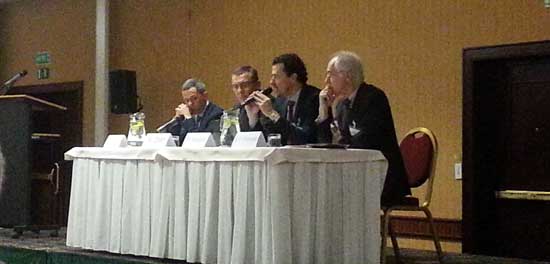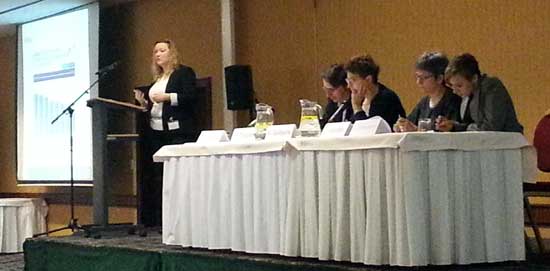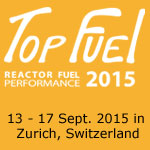

PIME 2015: Embracing and communicating change
From 1 – 4 March 2015, the Slovakian capital city of Bratislava played host to PIME 2015, the ENS flagship conference for nuclear communicators. This annual event has been going on for well over a quarter of a century and has established itself as the benchmark conference for the nuclear industry’s communications professionals. Around 100 communicators from across the world, including China, Japan, South Africa, Canada, the US and Russia, gathered in Bratislava to discuss the burning communications issues of the day, to share experiences - successes and failures, and to identify new solutions to the many challenges that communicators face in today’s fast-changing and information-hungry world. For the tightly-knit international community of nuclear communicators PIME also provides a golden opportunity to meet and network with fellow professionals and to reconnect with friends and colleagues who share the same objectives.
Day 1
PIME 2015 kicked off with a welcome address from Michele Bologna, Director of External Relations at the conference hosts, Slovenske Elektrarne, which is an ENEL Group company. During the traditional host country presentation Miroslav Obert, State Secretary for Economy of the Slovak government then gave an overview of the nuclear scene in Slovakia, stressing how for his country nuclear energy is so vital for a well-functioning energy market and for achieving the low-carbon goals - not just of Slovakia, but also of the EU. He also outlined the many communications activities that the government has launched to engage and inform stakeholders in Slovakia.
Next up on stage was Nicola Cotugno, CEO of Slovenske Elektrarne. He gave a detailed account of his company’s activities in Europe, Latin America, Africa, etc. Slovakia has four reactors currently in operation at Bohunice NPP and Mochovce NPP. It is also flying the new build flag with units 3 and 4 planned at Mochovce by 2016 and 2017 respectively. Slovakia also has some thermal, hydro and solar plants, but nuclear is the largest energy producer in the country, providing 52% of its electricity. Mr. Cotugno said that Slovenske Elektrarne are proud of the low-carbon footprint left by the Slovakian nuclear sector and stressed how the company is continually seeking to decrease its impact on the country’s environment with, among other things, activities aimed at reducing its liquid waste production.
Nuclear for Climate
Jean-Pol Poncelet, Secretary General of ENS, welcomed ‘Pimers’ on behalf of ENS and thanked both the first speakers for their interventions. He first presented the results of the Nuclear Industry Summit (NIS2014) that took place in Amsterdam in March 2014, before talking about the recently-launched Nuclear for Climate initiative that brings together nuclear societies and associations from across the world that are keen to promote the climate change credentials of nuclear energy ahead of the COP21 climate talks scheduled for Paris (December 2015). The initiative was partly inspired by the successful social media campaign that underpinned NIS2014.

After the opening speeches representatives of the five communications campaigns shortlisted for the PIME 2015 Award for Communications Excellence came up on stage to ‘sell’ their respective campaigns to PImers. The campaigns were also on permanent display during the coffee and lunch breaks and, ultimately, delegates were able to discuss the campaigns with their creators and carry out a peer review of each one, before voting for their choice as the winner of the award.
Getting your messages and tools right
The first plenary session was entitled: Successful communications – getting your messages and tools right. It focused primarily on ways of increasing the impact and outreach of your organisation by articulating messages that are tailor-made to suit to specific target audiences. This was also the central theme of the presentation given by a Dutch consultant, Anke Laarhuis, from Buro Blink, who stressed that communicators must strive to better understand the motivations and expectations of their specific audiences if they want to turn what is often a sterile monologue into a positive dialogue. Buro Blink has developed a new strategy based on five storylines that target different audiences. But first it is vital to determine what the ‘brand personality’ and characteristics are for every specific audience. For example, one of the storylines was targeted at 8-16 year olds and was created by educational and cultural partners.
Miel van Opstal, from Wavelab (Belgium) then turned Pimers’ attentions to how communicating visual content via the boiling cauldron of social media can pay dividends. He stated that research shows that 90% of the information transmitted to our brain is visual. He also emphasised how Twitter is betting big on its ‘native video player,’ and on how Facebook and Youtube are competing head-on through the power of visual communications.
Workshops and break-out sessions
The two aforementioned plenary presentations then featured large during the afternoon’s workshops, where they were further developed with the hands-on participation of delegates. There were three workshops on offer, which were entitled: Towards receiver-oriented communications, Communicating with videos and Using the opportunity of an international event for communications – looking at the examples of the Nuclear Industry Summit 2014 and COP 21. In the last-mentioned workshop (which the author of this report attended) Bonnie Forster (Urenco), Eric van Leeuw (COVRA) and Isabelle Jouete (SFEN) analysed how important global events like NIS 2014 and COP21 provide an invaluable opportunity to draw attention to the benefits of nuclear energy to a large international audience. Isabelle presented in detail the Nuclear for Climate campaign that Jean-Pol Poncelet had flagged in his opening speech. Then delegates were divided into small teams and set about defining objectives and actions and to deliver results. The results of all three workshops were then presented and discussed in plenary.
The influence of economic and political change
In the afternoon plenary session the focus switched to the subject of: Building a case for nuclear – how political and economic developments influence communications strategies. Political, social and economic climates are changing all the time. This influences communications strategies that continually need to adapt and refocus in order to keep pace with events. Communicators must adapt to change or risk not connecting with their audiences.
Takuya Hattori, from the Japan Atomic Industry Forum; Marielle Rogie, from the Belgian Nuclear Forum; Valentina Dinu, from Nuclearelectrica (Romania) and Li Jianwei from State Nuclear Power Technology Corporation (China) then gave an overview of the communications challenges associated with economic and political change in their respective countries, countries that have very different cultural and social profiles. Among the tools they outlined as useful in helping to readjust the communications strategy cope with change were synchronising the strategy with the individual market context, and carrying out ‘image indicator’ analysis.
Unforgettable evening
After a long day discussing key issues, working in break-out sessions and learning from the experiences of others Pimers were able to relax and enjoy the amazing hospitality offered by the hosts, Slovenske Elektrarne, during the Gala Dinner that took place at the Old Market Hall in downtown Bratislava. In the impressive surroundings of what was once the largest covered market in the city delegates enjoyed a buffet lunch and were blown away by a stunning display of Slovakian folk music and dance by an electric band of musicians and dancers. It was a memorable end to a very busy day.
Day 2
On Day 2 the PIME 2015 spotlight fell on the first plenary session of the day, entitled: Opinion polls.
The first speaker was Peter Thijssen, of M2P Media, Movement & Politics, University of Antwerp (Belgium), who asked the central question: Are opinion polls a research tool or a communications device? He explored the relationship between the media, opinion polls, politics and democracy and to what extent the media shape rather than reflect public opinion when covering the results of polls. He also explained when the public can experience the ‘bandwagon’ or ‘underdog’ effect that poll results create. Finally, he cast doubt on the use of poll sampling based on ‘loaded’ or biased demographics.
Citizens’ committees
Isabelle Jouette of SFEN then described how her organisation participated in ‘citizen committees’ and used telephone and face-to-face interviews to collect opinion data during France’s national debate on energy transition. In this way, she said, SFEN was able to keep its finger on civil society’s pulse and engage with stakeholders. She outlined how respondents’ reactions to nuclear can be broadly characterised according to five main categories: ‘confidents,’ ‘resigned,’ ‘reasonable realists’, ‘anxious realists’ and ‘opponents.’
Delegates were able also to appreciate from these debates how long-term operation is not a real subject of discussion, and that the only genuine debate is ‘nuclear or no nuclear.’ Those lessons were incorporated into their overall communications strategy.

Opinion polls and communications strategy
The final speaker was Sarah Crane of the UK’s Nuclear Industry Association (NIA). Her presentation looked at how opinion polls can be integrated into a broader communications strategy to emphasise key messages about new build, decommissioning and climate change. She stressed the importance of regional perspectives and motivations, of credible spokespersons and advocates, and of which methodology to adopt to make the most out of opinion polls. Following the presentations the three speakers were joined in a panel debate with the floor by Lenka Ferencakova, Editor-in-Chief of Energia.sk.
Attention then switched to three workshop topics from which Pimers were able to choose. The first one, Using opinion polls in a communications strategy, was chaired by Nathalie Guillaume of the CEA (France’s ‘Atomic and Alternative Energy Commission’). It focused on examples of the approaches used and methodologies adopted in different and how opinion polling is a mainstay of respective communications strategies in their countries, providing participants with a list of ‘do’s’ and ‘don’ts’. Among those who presented case studies and animated the debate were Christian Taillebois, of EDF, Katarzyna Wlodek-Makos, of PGE (Polish utility), Matthias Meersschaert, of the Belgian Nuclear Forum and Nathalie Guillaume herself.
The economics of nuclear
The second workshop was entitled: The economics of nuclear. The debate was animated by Marco Streit of the Paul Scherrer Institute in Switzerland (a former President of ENS) and Lubomir Mitev, a correspondent at NucNet. Participants in this workshop analysed the important economic vectors relating to nuclear and explored the dynamics of nuclear economics in general. Among the issues discussed were the liberalisation of energy markets, grid interconnections and the controversial subject of subsidies.
Debunking myths
The final workshop looked at the topic of: Debunking nuclear myths – the pre-conceived and ideology-driven misconceptions that wrongly drive public opinion and that are regularly targeted by nuclear communicators keen to expose the myths and reveal the truth. Eileen Radde, Co-chairwoman of the ENS Young Generation Nuclear ENSYGN), and Jeremy Gordon of the World Nuclear Association (WNA) examined how public opinion with regards to nuclear energy can be guided by scientific fact or by entrenched ideological positions. It is the job of nuclear communicators to present the facts in an interesting, understandable and engaging way so that they can debunk those myths and misconceptions; it’s all about setting the record straight and hammering home the message about the real benefits of nuclear energy.
The afternoon plenary session focused on a topic that has regularly featured at PIME conferences over the years, namely Learning from other industries. Two different industries, the medical and the space exploration sectors, provided fascinating insights into the particular challenges that each sector faces. Delegates were able to assess how the nuclear industry might learn something from their communications strategies, tools and methods, and potentially apply it to their own context.
Organ transplantation
The first speaker was Juliette van der Laan of the company Eurotransplant, in the Netherlands, an organisation that operates in the human organ transplantation sector. Juliette, who had previously worked for many years in the nuclear sector, highlighted the serious ethical and social questions that shape their communications strategy. It is, like nuclear, a topic that arouses great sensitivities and emotions, and is often perceived as being controversial. But, like nuclear, saving lives through providing organ transplants has a vital contribution to make to citizens’ quality of life. She particularly focused on the use of media, social media, public awareness campaigns and best communications practices. Unlike nuclear, however, Juliette emphasised how organ transplantation is ‘a very personal choice, ‘whereas nuclear is ‘just there.’
Exploring outer space
The final workshop, which was also the final session of the conference, was a visually inspiring and unforgettable presentation on the deep space exploration work carried out by the European Space Agency’s (ESA) for its renowned Rosetta mission. Mark McCauchrean, of ESA, introduced Pimers to the Rosetta mission, which consisted of landing the Philae probe on a comet in outer space - Comet 67P/Churymov-Gerasimenko. This was historical achievement - the first time in history such an incredible feat had been achieved. The extraordinary film footage of the mission and the other visual productions and communications tools created around the ground breaking Rosetta mission were very impressive and helped ESA to communicate in an inspirational way about what is a highly complex technological issue.
Closing session
|
After the previous presentation delegates were literally brought back to Earth with the Closing Session. Jean-Pol Poncelet announced the winner of the 2015 PIME Award for Communications Excellence: it was Slovenske Eletrarne for for their new state-of-the-art visitor centre, called Energoland. Robert Holy, Head of NPP Communications at Slovenske Elektrarne, went up on stage to collect the award accompanied by great applause. To win on home soil was particularly meaningful for Slovenske Elektrarne. Energoland features the very latest ‘edutainment’ tools, hands-on interactive exhibits, clearly explained displays and info-graphs and the very latest in 3-D audio-visual technology. The result is a highly interactive and evocative world presented in a unique atmosphere, where visitors can learn in a fun way (what it referred to as ‘A new dimension of knowledge’) about the central place that nuclear energy has always had in the history of the planet. It won a clear majority of Pimers’ votes. From a communications perspective it sets the bar very high. |
Jean-Pol Poncelet then delivered his closing speech, thanking the hosts and sponsors, congratulating the organisers of the conference and the many speakers and moderators who animated the agenda, and providing some personal observations and thoughts on the conference. Finally, he officially brought the PIME 2015 conference to a close with a traditional farewell drink.
Technical tours
The following day, delegates who had stayed on in Bratislava for the technical tours were given a choice of two venues to visit: the Mochovce NPP with its brand new Energoland Visitor Centre at the Mochovce NPP, which could now proudly proclaim itself as winner of the PIME 2015 Award for Communications Excellence, or the Bohunice V2 NPP. The author of this report visited Energoland, where Robert Holy and his team were the tour guides. It was easy to see why it had won the approval of so many communications specialists and won the 2015 PIME Award for Communications Excellence!
For further information regarding the conference visit the PIME 2015 website at: http://www.euronuclear.org/events/pime/pime2015/index.htm
Mark O’Donovan, Editor-in-Chief of ENS NEWS
|






